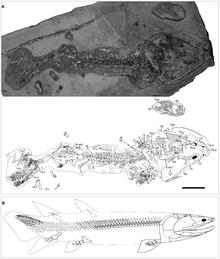Tinirau clackae
| Tinirau clackae | |
|---|---|

| |
| Holotype fossil and interpretive drawing of Tinirau clackae | |
| Scientific classification | |
| Domain: | Eukaryota |
| Kingdom: | Animalia |
| Phylum: | Chordata |
| Clade: | Sarcopterygii |
| Clade: | Tetrapodomorpha |
| Clade: | Eotetrapodiformes |
| Genus: | †Tinirau Swartz, 2012 |
| Species: | †T. clackae
|
| Binomial name | |
| †Tinirau clackae Swartz, 2012
| |
| Synonyms | |
|
Bruehnopteron murphyi Schultze & Reed (2012)?[1] | |
Tinirau is an extinct
Description

Tinirau was a fairly large, predatory fish about a meter long and with a deep, compact body. The head was large, with large terminal mout and numerous teeth. The tail was
It shares many advanced features with later tetrapodomorphs in the
Like those of the Late Devonian Panderichthys and Ichthyostega, the glenoid of Tinirau is elongated along the anteroposterior (forward-backward) axis of the body. The lengthening of the glenoid corresponds with a flattening of the proximal end of the humerus, a feature common in the forelimbs of more advanced stem tetrapods. Although the pectoral limb bones and girdle were not strong enough to support the weight of Tinirau out of water, glenoid lengthening and other changes to the proximal forelimb were among the first steps in the transformation from pectoral fin to forelimb.[2]
History
Remains of Tinirau were first discovered by paleontologist
Tinirau clackae was named by paleontologist Brian Swartz in 2012 after
Phylogeny
In
| Tetrapodomorpha |
| ||||||||||||
On the other hand, Parfitt et al. (2014) considered it more likely that Tinirau was a member of the family Tristichopteridae.[1]
